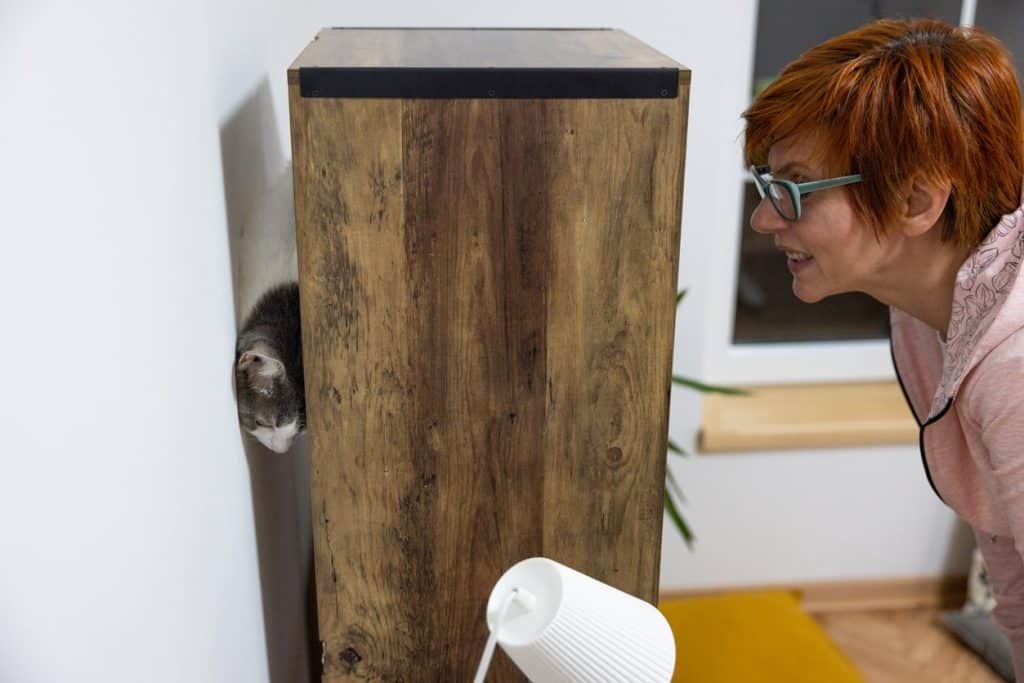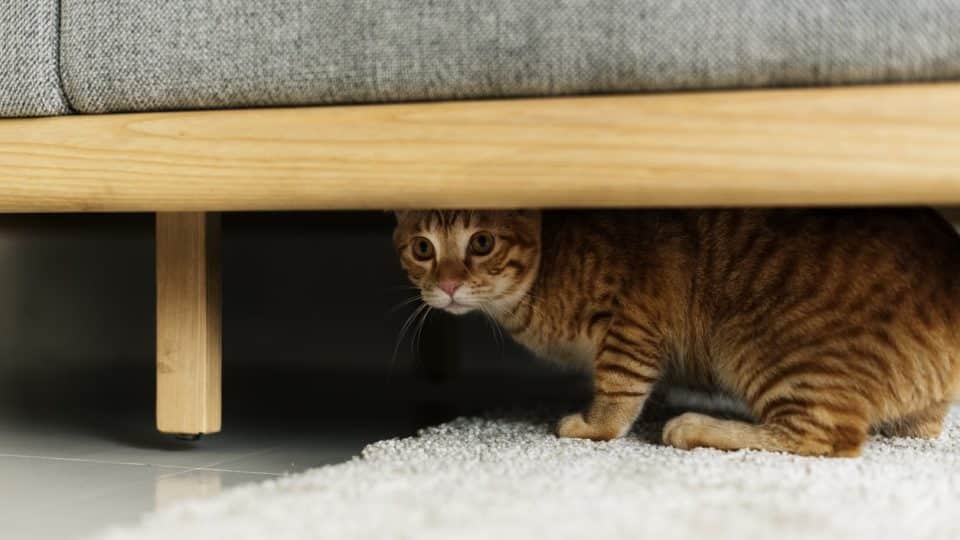One minute, your cat is zooming around the house. The next, they’re curled up in the depths of your closet, not to be seen again until you crack open a can of cat food. So, why? Hiding is a natural behaviour, even for healthy cats. But it can also be a sign of a problem if your cat suddenly hides or is hiding longer or more than usual.
To get the scoop on when hiding in cats is normal and when it’s not, we checked in with Stephen Quandt, a USA-based feline training and behaviour specialist and founder of Stephen Quandt Feline Behavior Associates, LLC. Below, Quandt and other experts explain when a cat’s hiding behaviours are normal and when to coax them out if necessary.
Why Do Cats Hide?
Hiding is an innate behaviour that serves myriad functions. In other words, your hiding cat might not just be scared.
Cats hide in boxes, in the back of closets, and even behind the fridge. Sometimes, they want to get cosy; other times, they hide due to stress or illness. The context and your cat’s body language are critical factors in determining why your cat feels the need to hide. The following are four common reasons cats hide.
They’re relaxing
A hiding cat might just be relaxing the best way they know how—curling up in a secluded spot. Quandt says there’s nothing to worry about if your cat appears to be happily napping, comes out for meals, and isn’t otherwise showing stress-related body language. “[They] should come out once [they] wake up,” he says.
They’re playing
Cats are natural hunters who often hide when they play to mimic hunting behaviour. In the wild, they typically hide in bushes, behind trees, and tall grasses while hunting, explains Dr Lindsay Butzer, DVM, spokesperson for PetMeds.
“Hunting requires many tactics and skills not to be seen,” she says. So don’t be surprised if your cat suddenly disappears into a clever hiding spot waiting to stalk and ambush their toys—or pounce as you walk by!

iStock/RyanJLane
They’re stressed
Cats are natural prey animals, so unfamiliar or threatening situations easily stress them. They may hide to protect themselves when they feel scared, anxious, or threatened. If your cat runs and hides when you take the cat carrier out or when your friend brings their dog over, chances are they’re trying to get somewhere safe.
Look at your cat’s body language while hiding, Quandt says. Any of these signs indicate a stress response:
- hunched posture
- the tail wrapped tightly around the body
- dilated pupils
- increased meowing
- defensive vocalisations, such as hissing or growling
- hair on end
Hiding can help cats destress. Studies have found that providing rescue cats boxes for hiding as they arrive at an animal shelter decreases their stress levels. This, in turn, reduces the time it takes them to recover from the transition and improves their overall health.
They’re in pain or feel ill
“It’s not uncommon for cats to hide when sick,” Quandt says. Cats are natural prey animals, so this protects them from appearing vulnerable to other animals.
Here are some signs that your cat may be hiding because they’re sick or in pain:
- missing meals
- changes in bathroom habits
- increased vocalisation
- lethargy
- vomiting or diarrhoea
- increased vocalisations when touched
- difficulty breathing
- drooling
Quandt says that if your cat suddenly begins hiding without appearing to be spooked by anything, it’s time to see a vet.
4 Tips for Coaxing Your Cat Out of Hiding
While hiding is often expected, sometimes we need our cats to come out. However, there’s a right and wrong way to do so. Below, Quandt and Butzer detail the surefire and stress-free ways cat parents can coax their kitties out of hiding.
- Be patient and understanding. If your cat hides after being scared, Quandt recommends giving them time to come out independently. But if they’ve been hiding longer than usual, you can try coaxing them out. Remember that if a cat you adopted is hiding, they may need a few days to adjust. Ensure they eat and use the bathroom when you’re not around by setting food and litter by the edge of the hiding spot.
- Talk to your cat in a soft, soothing voice. Speaking softly can help to calm cats down and make them feel more relaxed. Even when they’re hiding, spending time in the same room will help them get acquainted with your voice and presence.
- Avoid making sudden movements or loud noises. Jerky, sudden moves could scare your cat and make them more likely to hide.
- Offer your cat their favourite food or toy. “I always recommend getting cat wands with bells or feathers and other toys that your cat will enjoy playing with,” Butzer offers.
Once your cat comes out of hiding, don’t force them to interact with you. Instead, let them come to you on their terms and provide an environment that allows them to safely hide when needed.

iStock/Constantinis
How To Provide A Safe Hiding Space For Your Cat
Hiding is a natural behaviour for cats, and it can serve many purposes, such as playing, decompressing from a stressful event, or relaxing. Providing safe places for your cat to hide can help them feel more comfortable and secure in their environment.
Offering safe hiding places can lead to a happier and healthier cat. “A stressed-out cat is prone to urinary tract infections, and offering your cat a place to hide might help stop this from happening,” Butzer offers as an example.
Keep these tips in mind when providing safe hiding places for your cat:
- Offer a variety of hiding places, such as cardboard boxes, cat caves, and cat trees.
- Place hiding spots in different parts of your home so they have options.
- Ensure the hiding places are comfortable and secure.
- Avoid placing cat furniture in areas where they might feel exposed or vulnerable.



